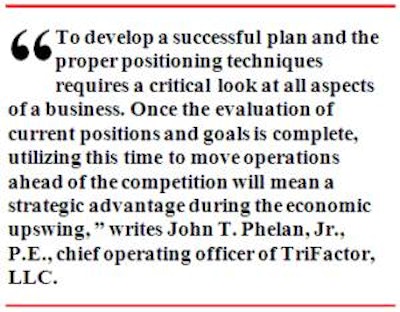
July 30, 2009 — Leading economic indicators show signs that many distribution sectors are stabilizing and are on track for recovery in 2010. The unforeseen force and speed of the economic downturn sent many companies reeling, rapidly retreating to a cost-reduction, survival mode. While the recovery is forecast to be slow and varied by sector, a dogmatic, "let's get through this" state of mind is a paralysis-creating mindset companies can ill afford.
History shows that companies focused on cost-cutting strategies during a recession seldom emerge as market leaders. McKinsey & Company, the prestigious international consulting firm, examined the pattern of declines and recoveries during recent recessions dating back to the 1970s. The February 2009 McKinsey Quarterly points out that in past recessions "businesses that followed countercyclical patterns of cash utilization and spending fared much better than those with purely defensive strategies."
Given the uncertain economic climate, mapping a strategic recovery plan is no easy task. There is an overarching sense that this recession means paradigm shifts of fundamental proportions, challenging the old ways of doing business. For companies to emerge stronger, increase market share and prosper when the economy recovers will take not only a realistic assessment of the business environment but also a serious, accurate self-diagnosis of operational capabilities, technological competence, skills, knowledge, flexibility and competitive positioning.
Here are nine reasons to start now:
1. To gain a holistic understanding of all the supply chain functions and costs
Controlling costs, maximizing productivity, increasing throughput, minimizing downtime and improving accuracy are traditional issues for companies that operate warehouses or distribution centers. Reduced workforces coupled with today's challenges of distributing a myriad of products and order sizes are a mandate to understand the new equipment, current technologies and systems on the market.
Understanding the opportunities, together with a comprehensive analysis of operations, broadens the thinking of the management team. The process can identify the top priorities and challenges that any new system must accommodate, without being handcuffed by department budget constraints and internal politics.
Now is the time to evaluate the supply chain process across the entire organization, to identify strengths and weaknesses and opportunities for improved integration, automation and efficiency. Many anticipate that demand volatility will be a part of the new normal; the agility to react quickly and ramp up capacity in response to upticks, as well as adjust to downturns, is paramount to profitability.
2. To take advantage of the buyer's market now
Buying assets at the bottom of an economic cycle makes good fiscal sense. In a move to leverage buying power in a disseminated market, United Airlines recently asked the two largest aircraft manufacturers, Boeing Co. and Airbus, to bid on an order to replace its wide body fleet.
Affordable and more flexible technology is available, and now is the time to research and determine what is the best fit for your company. When the turnaround occurs, companies that have planned for it will benefit and operate from a position of competitive strength.
3. To understand your customers' pain
Even before the recession, companies had begun to rethink distribution strategies. With more and more customers demanding shorter delivery times, proliferating SKUs as product offerings expand, and contracting product lifecycles adversely affecting inventories, companies sought better ways to manage distribution. Some moved from the traditional hub-and-spoke network to smaller DCs closer to the point of sale. Others sought better segmentation of products or invested in more efficient, highly automated and environmentally friendly systems, still others reduced outsourcing from Asia.
Now is the time to get closer to your customer. It will give you key insights into how to improve your product and services. Impeccable service no longer suffices; it's about improving your customer's economic performance.
4. To plan even with a reduced engineering staff
With engineering departments downsized — and in some cases, eliminated — companies need time to properly execute a redistribution of responsibilities. Due to time constraints or lack of expertise, the remaining in-house engineers may be focused on ad hoc solutions rather than thinking about the "big picture" — a robust, yet flexible supply chain system that generates the level of cost reduction and quality improvement needed to be competitive.
Outsourcing is an option, a way to move from fixed to variable costs. Successfully outsourcing engineering functions requires careful selection of a partner that understands your business, your supply chain challenges, your customers' priorities and how to effectively work with your leaner organization. In some cases, a relationship that goes beyond a needs assessment and integrates planning and execution can lead to quicker completion and measurable cost savings, as well as single source responsibility.
5. To achieve market advantage with green initiatives
While the economic crisis may have slowed green initiatives, they are essential for future business success and are becoming more affordable and cost-effective. For example, "green" conveyors provide a combination of efficiency, ergonomic design, low maintenance and energy savings, while offering incredible flexibility.
As compliance and regulation around green, as well as consumer accountability, become increasingly prevalent, companies that are greener can tout their capabilities and gain market advantage. In addition, while staff turnover is less of a problem today, given the current economic climate, long-term, it remains an industry issue. An environmentally friendly work environment is leverage to attract the best talent.
6. To be a top competitor among 3PLs
As the third-party logistics (3PL) industry continues to mature, the gap between customer expectations and the current technological capabilities of 3PLs is a challenge to the industry. Studies show sustainability, security and technology as the crucial areas on which 3PL providers must focus. The pressures to keep supply chain management efficient and priced right for customers dictate that 3PLs explore innovative technological solutions to retain and grow market share in the economic recovery.
7. To provide ample lead time
Whereas mature companies understand the time it takes to plan, design and implement a material handling project, fast-growing companies — and others who aren't as automation aware — have little idea. While time factors vary with the nature and complexity of the project, a good rule of thumb is that the design and cost estimate phase will take three to four months, and implementation will take six to nine months. Reengineering jobs typically take longer, while installations in new buildings will be quicker.
8. To steal a bargain before costs rise
There is no magic crystal ball; however, it seems irrefutable that the enormous government debt incurred by the economic stimulus, the continued growth in unfunded liabilities such as Social Security as well as proposed initiatives such as national health care will be funded through additional taxes. Companies that have a plan in place and can take decisive action before taxes rise will have a significant economic advantage.
9. To be ahead of the curve
Conditions and demands constantly change, and there is always a better, more efficient way to do business. While tweaking an existing business model may be enough for strong companies, for others, major changes in processes must occur to be competitive. The most successful organizations use this time to gain strategic advantage by overcoming inertia, dissecting the costs to deliver, streamlining internal processes and leveraging technology to optimize the order-to-delivery cycle.
Continuing supply chain complexity, costs, sustainability and customer focus will drive investments in optimization and modernization. Now is time to examine information technology and physical systems with an eye towards maximizing flexibility and real ROI.
To develop a successful plan and the proper positioning techniques requires a critical look at all aspects of a business. Once the evaluation of current positions and goals is complete, utilizing this time to move operations ahead of the competition will mean a strategic advantage during the economic upswing.
About the Author: John T. Phelan, Jr., P.E. is chief operating officer of TriFactor, LLC, a material handling systems integrator based in Lakeland, Fla. He can be contacted at 863-577-2243 or [email protected]. For more information visit www.trifactor.com
History shows that companies focused on cost-cutting strategies during a recession seldom emerge as market leaders. McKinsey & Company, the prestigious international consulting firm, examined the pattern of declines and recoveries during recent recessions dating back to the 1970s. The February 2009 McKinsey Quarterly points out that in past recessions "businesses that followed countercyclical patterns of cash utilization and spending fared much better than those with purely defensive strategies."
Given the uncertain economic climate, mapping a strategic recovery plan is no easy task. There is an overarching sense that this recession means paradigm shifts of fundamental proportions, challenging the old ways of doing business. For companies to emerge stronger, increase market share and prosper when the economy recovers will take not only a realistic assessment of the business environment but also a serious, accurate self-diagnosis of operational capabilities, technological competence, skills, knowledge, flexibility and competitive positioning.
Here are nine reasons to start now:
1. To gain a holistic understanding of all the supply chain functions and costs
Controlling costs, maximizing productivity, increasing throughput, minimizing downtime and improving accuracy are traditional issues for companies that operate warehouses or distribution centers. Reduced workforces coupled with today's challenges of distributing a myriad of products and order sizes are a mandate to understand the new equipment, current technologies and systems on the market.
Understanding the opportunities, together with a comprehensive analysis of operations, broadens the thinking of the management team. The process can identify the top priorities and challenges that any new system must accommodate, without being handcuffed by department budget constraints and internal politics.
Now is the time to evaluate the supply chain process across the entire organization, to identify strengths and weaknesses and opportunities for improved integration, automation and efficiency. Many anticipate that demand volatility will be a part of the new normal; the agility to react quickly and ramp up capacity in response to upticks, as well as adjust to downturns, is paramount to profitability.
2. To take advantage of the buyer's market now
Buying assets at the bottom of an economic cycle makes good fiscal sense. In a move to leverage buying power in a disseminated market, United Airlines recently asked the two largest aircraft manufacturers, Boeing Co. and Airbus, to bid on an order to replace its wide body fleet.
Affordable and more flexible technology is available, and now is the time to research and determine what is the best fit for your company. When the turnaround occurs, companies that have planned for it will benefit and operate from a position of competitive strength.
3. To understand your customers' pain
Even before the recession, companies had begun to rethink distribution strategies. With more and more customers demanding shorter delivery times, proliferating SKUs as product offerings expand, and contracting product lifecycles adversely affecting inventories, companies sought better ways to manage distribution. Some moved from the traditional hub-and-spoke network to smaller DCs closer to the point of sale. Others sought better segmentation of products or invested in more efficient, highly automated and environmentally friendly systems, still others reduced outsourcing from Asia.
Now is the time to get closer to your customer. It will give you key insights into how to improve your product and services. Impeccable service no longer suffices; it's about improving your customer's economic performance.
4. To plan even with a reduced engineering staff
With engineering departments downsized — and in some cases, eliminated — companies need time to properly execute a redistribution of responsibilities. Due to time constraints or lack of expertise, the remaining in-house engineers may be focused on ad hoc solutions rather than thinking about the "big picture" — a robust, yet flexible supply chain system that generates the level of cost reduction and quality improvement needed to be competitive.
Outsourcing is an option, a way to move from fixed to variable costs. Successfully outsourcing engineering functions requires careful selection of a partner that understands your business, your supply chain challenges, your customers' priorities and how to effectively work with your leaner organization. In some cases, a relationship that goes beyond a needs assessment and integrates planning and execution can lead to quicker completion and measurable cost savings, as well as single source responsibility.
5. To achieve market advantage with green initiatives
While the economic crisis may have slowed green initiatives, they are essential for future business success and are becoming more affordable and cost-effective. For example, "green" conveyors provide a combination of efficiency, ergonomic design, low maintenance and energy savings, while offering incredible flexibility.
As compliance and regulation around green, as well as consumer accountability, become increasingly prevalent, companies that are greener can tout their capabilities and gain market advantage. In addition, while staff turnover is less of a problem today, given the current economic climate, long-term, it remains an industry issue. An environmentally friendly work environment is leverage to attract the best talent.
6. To be a top competitor among 3PLs
As the third-party logistics (3PL) industry continues to mature, the gap between customer expectations and the current technological capabilities of 3PLs is a challenge to the industry. Studies show sustainability, security and technology as the crucial areas on which 3PL providers must focus. The pressures to keep supply chain management efficient and priced right for customers dictate that 3PLs explore innovative technological solutions to retain and grow market share in the economic recovery.
7. To provide ample lead time
Whereas mature companies understand the time it takes to plan, design and implement a material handling project, fast-growing companies — and others who aren't as automation aware — have little idea. While time factors vary with the nature and complexity of the project, a good rule of thumb is that the design and cost estimate phase will take three to four months, and implementation will take six to nine months. Reengineering jobs typically take longer, while installations in new buildings will be quicker.
8. To steal a bargain before costs rise
There is no magic crystal ball; however, it seems irrefutable that the enormous government debt incurred by the economic stimulus, the continued growth in unfunded liabilities such as Social Security as well as proposed initiatives such as national health care will be funded through additional taxes. Companies that have a plan in place and can take decisive action before taxes rise will have a significant economic advantage.
9. To be ahead of the curve
Conditions and demands constantly change, and there is always a better, more efficient way to do business. While tweaking an existing business model may be enough for strong companies, for others, major changes in processes must occur to be competitive. The most successful organizations use this time to gain strategic advantage by overcoming inertia, dissecting the costs to deliver, streamlining internal processes and leveraging technology to optimize the order-to-delivery cycle.
Continuing supply chain complexity, costs, sustainability and customer focus will drive investments in optimization and modernization. Now is time to examine information technology and physical systems with an eye towards maximizing flexibility and real ROI.
To develop a successful plan and the proper positioning techniques requires a critical look at all aspects of a business. Once the evaluation of current positions and goals is complete, utilizing this time to move operations ahead of the competition will mean a strategic advantage during the economic upswing.
About the Author: John T. Phelan, Jr., P.E. is chief operating officer of TriFactor, LLC, a material handling systems integrator based in Lakeland, Fla. He can be contacted at 863-577-2243 or [email protected]. For more information visit www.trifactor.com

















